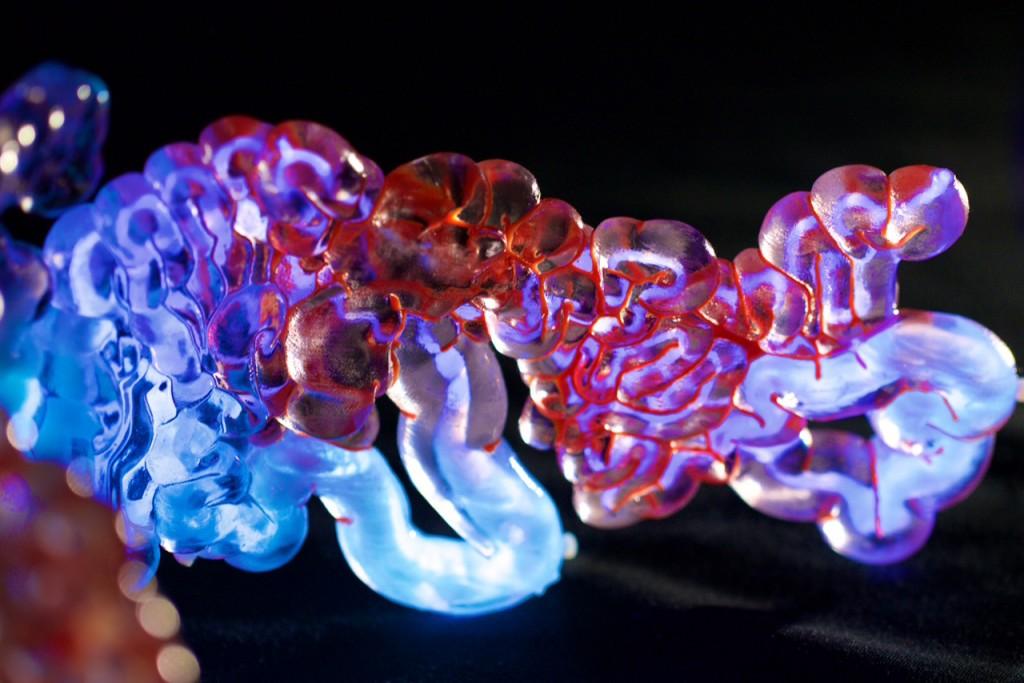When Neri Oxman is in the news, it’s bound to be fascinating. This time around is no disappointment. Back in 2014, we covered her use of Stratasys’ triple-jetting technology in the creation of ‘wearable skins.’ In the article, staff writer Sarah Anderson noted that the aim of Oxman and her team was to be able to embed living matter into their pieces.
Today, Stratasys announced that Oxman has achieved her goal and unveiled her latest creation Mushtari on the stage of TED2015 in Vancouver. The pieces are created not only to allow for living organisms to inhabit them, but also to intentionally manipulate the functions of those organisms. Don’t worry, this isn’t the herald of some dystopian state in which human beings are called ‘organisms’ and enslaved by 3D printed suits. Instead, the occupants are microorganisms such as cyanobacteria and E. coli.
Oxman explained her contribution and its context:
“We live in a special time…This is the first time that 3D printing technology has been used to produce a photosynthetic wearable piece with hollow internal channels designed to house microrganisms. Inspired by the human gastrointestinal tract, Mushtari is designed to host synthetic microorganisms – a col-culture of photosynthetic cyanobacteria and E. coli bacteria – that can fluoresce bright colors in darkness and produce sugar or biofuels when exposed to the sun. Such functions will in the near future augment the wearer by scanning our skins, repairing damaged tissue and sustaining our bodies, an experiment that has never been attempted before.”

A piece of Mushtari filled with luminescent liquid. Photo credit: Jonathan Williams and Paula Aguilera, courtesy of Mediated Matter
Mushtari, the Arabic word for Giant and used to reference the planet Jupiter, is part of a series of pieces by Oxman in a series called Wanderers: An Astrobiological Exploration. The fusion of art and science has never been so clear and stands as a clear testament to the false nature of the division between art and technology.

Neri Oxman’s lauded TED Talk reveals Stratasys 3D printed wearable designed to host living matter in another world’s first. Photo credit: Bret Hartman, courtesy of TED
The relationship between Oxman’s team and the team at Stratasys is as symbiotic as Mushtari promises to be. Rather than a development in technology leading to a new application, the desire for an application works hand in hand with the development of the technology. It is the design process at its best: a projected future and the multi-modal effort to address a wicked problem.
The Creative Director for Art & Fashion Design at Stratasys, Naomi Kaempfer, described the co-investigative nature of the project:
“We have a fertile research collaboration with Professor Neri Oxman, one that has great reciprocal benefits as we push each other to the edges of expression and technological capability. 3D printing Mushtari is a wonderful example of how far this collaboration can bring us. The fluid channels in the wearable stretch to around 58 m, with an inner channel diameter ranging from 1 mm to 2.5 cm, frequently turning sharply in new directions. Clearing the support material out from such a long, narrow, and complex structure to create the hollow channels for living matter presented a significant challenge. Our R&D team went beyond the boundaries of our existing technology, formulating a dedicated improved support structure to allow a smooth, effective process in support of Professor Oxman’s vision.”
In this latest step Oxman foresees a future in which we don’t simply design with nature but rather can begin to design nature itself. While this is not the first time that such grandiose claims have been made, Oxman seems closer than most. Let us know what you think about Oxman’s creations in the Wearable Skin forum thread on 3DPB.com.
Subscribe to Our Email Newsletter
Stay up-to-date on all the latest news from the 3D printing industry and receive information and offers from third party vendors.
You May Also Like
Nylon 3D Printed Parts Made More Functional with Coatings & Colors
Parts 3D printed from polyamide (PA, Nylon) 12 using powder bed fusion (PBF) are a mainstay in the additive manufacturing (AM) industry. While post-finishing processes have improved the porosity of...
3DPOD Episode 193: Flow and What’s Possible in 3D Printing with Ricky Wildman, University of Nottingham
Ricky Wildman is working on 3D printing pills, but, as Professor of Multiphase Flow and Physics at Nottingham, he does a whole lot more. His research encompasses the characterization of...
3D Printing Webinar and Event Roundup: March 17, 2024
It’s another busy week of webinars and events, including SALMED 2024 and AM Forum in Berlin. Stratasys continues its in-person training and is offering two webinars, ASTM is holding a...
3D Printed Micro Antenna is 15% Smaller and 6X Lighter
Horizon Microtechnologies has achieved success in creating a high-frequency D-Band horn antenna through micro 3D printing. However, this achievement did not rely solely on 3D printing; it involved a combination...






























